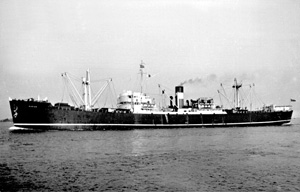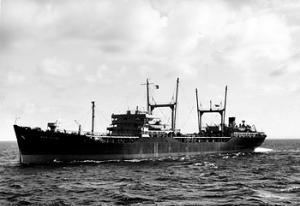
SS Empire Galahad was a refrigerated cargo ship built in 1942 and scrapped in 1967. She was also called SS Celtic Star (1946), SS Murillo (1946–52), SS Bogliasco (1952–54), MV Bogliasco (1954–63) and MV Ocean Peace (1963–67). She was built as a steamship, but in 1954 she was converted into a motor ship. She was scrapped in Taiwan in 1967.

SS Hilary was a British steam passenger liner that was built in 1931 and scrapped in 1959. She spent much of her career on a scheduled service between Liverpool in England and Manaus in Brazil.

HMS Cicero was an infantry landing ship in service with the Royal Navy during the late stages of the Second World War.

HMS Rocksand was an infantry landing ship in service with the Royal Navy during the late stages of the Second World War. She was launched in 1943 as Cape Argos and renamed Empire Anvil before being taken into Royal Navy service. Postwar she reverted to Empire Anvil and then Cape Argos and back to Empire Anvil again. She spent ten years laid up before resuming service as Hai Ya and Fu Ming before being scrapped in 1974.
HMS Sansovino was an infantry landing ship in service with the Royal Navy during the late stages of the Second World War.
Empire Airman was a 9,813 ton tanker that was built in 1941. She was renamed San Wenceslao in 1946 and served until 1959 when she was scrapped.
Empire Archer was a 7,031 ton cargo ship which was built in 1942. She was renamed Baron Murray in 1946. In 1959 she was renamed Cathay, serving until 1963 when she was scrapped.
SS Empire Clansman was a 2,065 ton collier which was built in 1942 for the Ministry of War Transport (MoWT). She saw service mainly in British coastal waters during the Second World War, before running aground and being badly damaged in 1945. She was subsequently salvaged and returned to service for several companies after the war, under the names Sheaf Field, Corfield and then Spyros Amrenakis, before being wrecked for a second and final time in 1965.
Savoia was a 5,490 ton refrigerated cargo ship which was built in 1922. She was captured by the Royal Navy in 1941 and renamed Empire Arun. In 1947 she was sold and renamed Granlake. Further name changes were Dryad in 1949, Shiranesan Maru in 1951 and Dainichi Maru in 1962. She was scrapped in 1968.
SS Empire Bunting was a 6,318 GRT cargo ship which was built in 1919. She saw service between the wars under the US flag and was transferred to the UK Ministry of War Transport in the Second World War. She made a number of cross-Atlantic voyages, often sailing in convoys. She ended her career by being sunk as a blockship on the Normandy coast, supporting the allied landings there in 1944.

RFA Wave Victor (A220) was an 8,187 GRT Wave-class fleet support tanker of the Royal Fleet Auxiliary built at Haverton Hill-on-Tees by Furness Shipbuilding Company. She was built in 1942 as Empire Bounty for the Ministry of War Transport (MoWT). She was transferred to the Royal Fleet Auxiliary in 1946 and renamed Wave Victor with Pennant number X130. Her pennant number was later changed to A220. She served until scrapped in 1981.

SS Letitia was an ocean liner built in Scotland for service with the Anchor-Donaldson Line. She continued to serve with its successor company Donaldson Atlantic Line. At the start of the Second World War in September 1939, the British Admiralty requisitioned the ship for service and had it converted to serve as an armed merchant cruiser. She was withdrawn from this service in 1941 to become a troop ship.
Empire Baron was a 5,890 GRT cargo ship which was built in 1926 for Navigazione Generale Gerolimich & Compagnia Società in Anzioni, Trieste, Italy. She was captured by the Royal Navy in 1940 and ownership passed to the Ministry of War Transport (MoWT). She was renamed Empire Baron. She was sold in 1947 to Navigation & Coal Trade Ltd, London and renamed Rubystone. She was sold to a Panamanian company in 1951 and was scrapped in 1960.
Empire Barracuda was a 4,972 GRT cargo ship which was built in 1918 for the United States Shipping Board (USSB) as Sacandaga. She was sold to American Diamond Lines in 1932 and renamed Black Heron. In 1941 she passed to the Ministry of War Transport (MoWT) and was renamed Empire Barracuda. She was torpedoed on 15 December 1942 and sunk by U-77.
SS Empire Morn was a 7,092-ton CAM ship that was built in 1941. She saw service on a number of trade routes during the Second World War, making several crossings of the North Atlantic as well as voyages to Russia and Africa. She was badly damaged after hitting a mine in 1943, and spent the rest of the war laid up as a hulk. She was subsequently sold and repaired, returning to service for several companies after the war, under the names San Antonio and Rio Pas before being sold for scrapping in 1973.
Polycrown was a 7,297 GRT cargo ship which was built by William Doxford & Sons, Sunderland in 1943 as Empire Beauty. Postwar she was sold into merchant service as Polycrown and saw further service as Ioannis Aspiotis and Laurel before she was scrapped in 1969.
Empire Bede was a 6,959 GRT cargo ship which was built by G M Harland & Wolff Ltd, Glasgow in 1942 for the Ministry of War Transport (MoWT). She had a short career, being damaged by a torpedo and then sunk by gunfire on 18 August 1942.
Empire Bowman was a 7,030 GRT cargo ship built in 1942 for the Ministry of War Transport (MoWT). Completed in May 1942, she served until 30 March 1943 when she was torpedoed and sunk by U-404. One of her crew was awarded an Albert Medal for his actions in the sinking.
HMS Empire Dace was a 716 GRT coastal ferry that was built in 1942 as a merchant ship by Swan, Hunter & Wigham Richardson Ltd Newcastle upon Tyne, United Kingdom for the Ministry of War Transport (MoWT). In 1943, she was requisitioned by the Royal Navy. She served until December 1944, when she struck a mine and sank in Greek waters.
Empire Dunstan was a 2,887 GRT cargo ship that was built in 1941 by Grangemouth Dockyard Co Ltd, Grangemouth, Stirlingshire, United Kingdom for the Ministry of War Transport (MoWT). Entering service in January 1942, she served until November 1943, when she was torpedoed and sunk by U-81.





